warning light PORSCHE 911 TURBO 2014 6.G User Guide
[x] Cancel search | Manufacturer: PORSCHE, Model Year: 2014, Model line: 911 TURBO, Model: PORSCHE 911 TURBO 2014 6.GPages: 300, PDF Size: 10.61 MB
Page 43 of 300

Seats, Mirrors and Steering Wheel 41
Seat adjustment for the passenger’s seat
Safety belts only offer protection when the backrest is positioned at an upright seating angle and the belts are properly positioned on the body.fDo not operate the car with the driver or passenger backrests excessively reclined.
Vehicle modifications to accommodate persons with disabilities
Because modifications to your vehicle could compromise your advanced airbag system, please call 1-800-PORSCHE prior to having your vehicle modified.
To reduce risk of injury or death to a child from an inflating airbag in an accident, Porsche strongly recommends:
Before transporting a child on the passenger seat:fPlease see the chapter “PASS AIR BAG OFF INDICATOR LAMP DOES NOT LIGHT UP” on page 42.fUnder all normal circumstances, the child seat must be placed in the rear. Do not use a child restraint system in the front passenger seat.
Automatic deactivation of the passenger airbag
Before transporting a child on the passenger seat:fPlease see the chapter “CHILD RESTRAINT SYSTEMS” on page 42.– When an up to one-year old child is seated in the child restraint system, the front airbag is automatically deactivated on the passenger side.– When an adult is seated in the passenger’s seat the front airbag is automatically activated.
PASS AIR BAG OFF indicator lamp
Information
Depending on the weight, body positioning and shape acting on the passenger's seat, it can occur in the case of heavier children that the passenger airbag is active or, in the case of very light adults or young persons, that the passenger airbag is deactivated.
The condition of the passenger airbag system is shown by the indicator lamp in the overhead operating console.If in doubt:fFasten the forward facing child restraint system on the rear seat or transport the passenger on the rear seat.
Reclining Passenger Seatback
WARNINGh
DANGERh
14_991_Turbo_21.book Seite 41 Mittwoch, 9. April 2014 2:19 14
Page 44 of 300
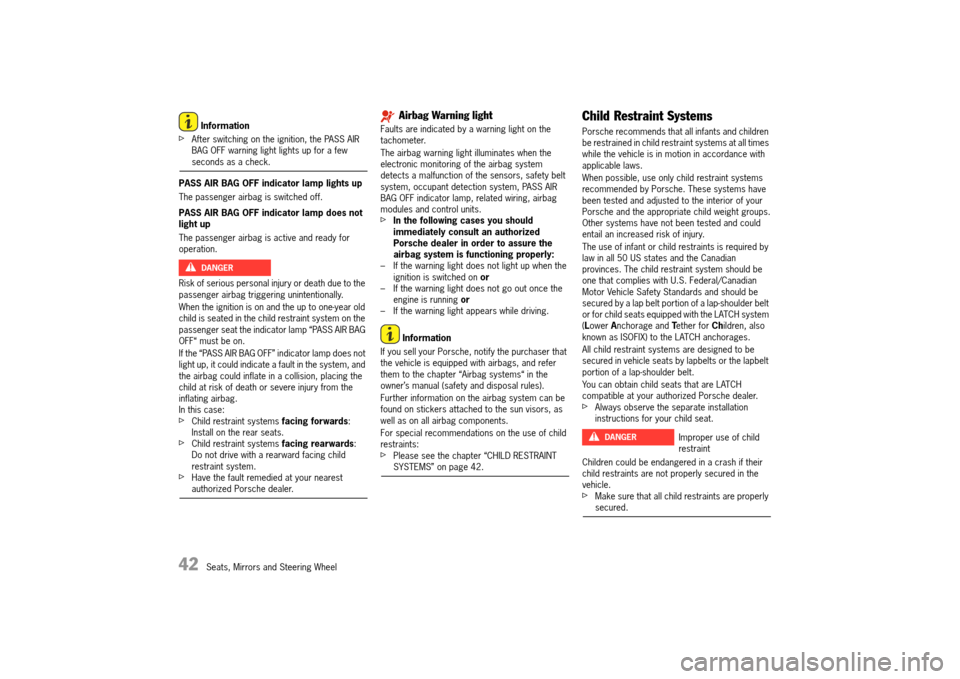
42 Seats, Mirrors and Steering Wheel
Information
fAfter switching on the ignition, the PASS AIR BAG OFF warning light lights up for a few seconds as a check.
PASS AIR BAG OFF indicator lamp lights up
The passenger airbag is switched off.
PASS AIR BAG OFF indicator lamp does not light up
The passenger airbag is active and ready for operation.
Risk of serious personal injury or death due to the passenger airbag triggering unintentionally.
When the ignition is on and the up to one-year old child is seated in the child restraint system on the passenger seat the indicator lamp “PASS AIR BAG OFF“ must be on.
If the “PASS AIR BAG OFF” indicator lamp does not light up, it could indicate a fault in the system, and the airbag could inflate in a collision, placing the child at risk of death or severe injury from the inflating airbag.In this case:fChild restraint systems facing forwards: Install on the rear seats.fChild restraint systems facing rearwards: Do not drive with a rearward facing child restraint system.fHave the fault remedied at your nearest authorized Porsche dealer.
Airbag Warning light
Faults are indicated by a warning light on the tachometer.
The airbag warning light illuminates when the electronic monitoring of the airbag system detects a malfunction of the sensors, safety belt system, occupant detection system, PASS AIR BAG OFF indicator lamp, related wiring, airbag modules and control units.fIn the following cases you should immediately consult an authorized Porsche dealer in order to assure the airbag system is functioning properly: – If the warning light does not light up when the ignition is switched on or – If the warning light does not go out once the engine is running or – If the warning light appears while driving.
Information
If you sell your Porsche, notify the purchaser that the vehicle is equipped with airbags, and refer them to the chapter “Airbag systems“ in the owner’s manual (safety and disposal rules).
Further information on the airbag system can be found on stickers attached to the sun visors, as well as on all airbag components.
For special recommendations on the use of child restraints:fPlease see the chapter “CHILD RESTRAINT SYSTEMS” on page 42.
Child Restraint Systems
Porsche recommends that all infants and children be restrained in child restraint systems at all times while the vehicle is in motion in accordance with applicable laws.
When possible, use only child restraint systems recommended by Porsche. These systems have been tested and adjusted to the interior of your Porsche and the appropriate child weight groups.Other systems have not been tested and could entail an increased risk of injury.
The use of infant or child restraints is required by law in all 50 US states and the Canadian provinces. The child restraint system should be one that complies with U.S. Federal/Canadian Motor Vehicle Safety Standards and should be secured by a lap belt portion of a lap-shoulder belt or for child seats equipped with the LATCH system ( Lower Anchorage and Tether for Children, also known as ISOFIX) to the LATCH anchorages.
All child restraint systems are designed to be secured in vehicle seats by lapbelts or the lapbelt portion of a lap-shoulder belt.
You can obtain child seats that are LATCH compatible at your authorized Porsche dealer.fAlways observe the separate installation instructions for your child seat.
Children could be endangered in a crash if their child restraints are not properly secured in the vehicle.fMake sure that all child restraints are properly secured.
DANGERh
Improper use of child restraint
DANGERh
14_991_Turbo_21.book Seite 42 Mittwoch, 9. April 2014 2:19 14
Page 45 of 300
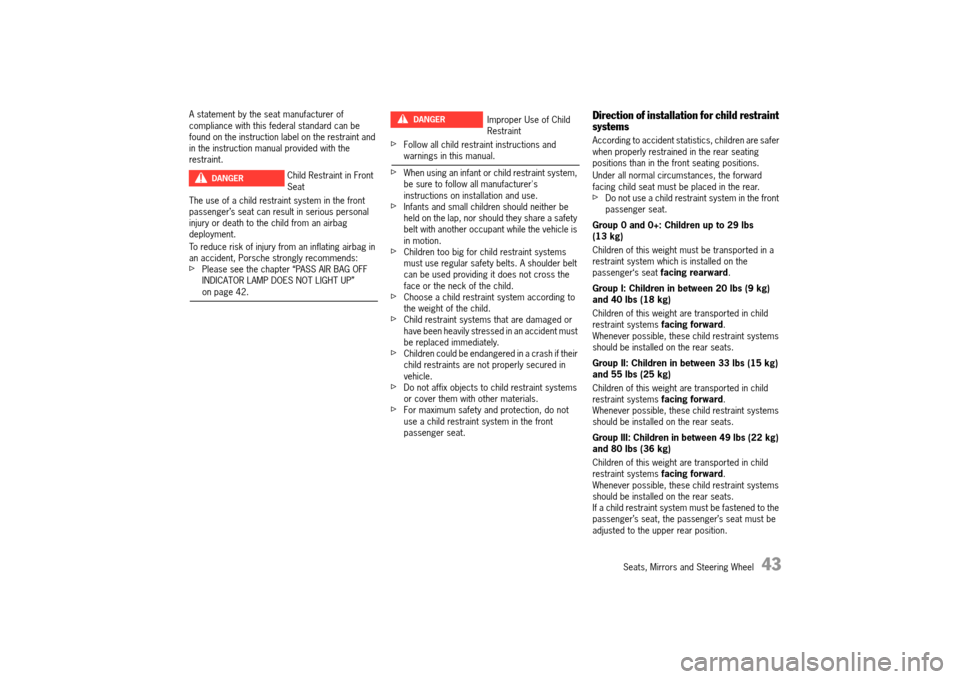
Seats, Mirrors and Steering Wheel 43
A statement by the seat manufacturer of compliance with this federal standard can be found on the instruction label on the restraint and in the instruction manual provided with the restraint.
The use of a child restraint system in the front passenger’s seat can result in serious personal injury or death to the child from an airbag deployment.
To reduce risk of injury from an inflating airbag in an accident, Porsche strongly recommends:fPlease see the chapter “PASS AIR BAG OFF INDICATOR LAMP DOES NOT LIGHT UP” on page 42.
fFollow all child restraint instructions and warnings in this manual.
fWhen using an infant or child restraint system, be sure to follow all manufacturer's instructions on installation and use.fInfants and small children should neither be held on the lap, nor should they share a safety belt with another occupant while the vehicle is in motion.fChildren too big for child restraint systems must use regular safety belts. A shoulder belt can be used providing it does not cross the face or the neck of the child.fChoose a child restraint system according to the weight of the child.fChild restraint systems that are damaged or have been heavily stressed in an accident must be replaced immediately.fChildren could be endangered in a crash if their child restraints are not properly secured in vehicle.fDo not affix objects to child restraint systems or cover them with other materials.fFor maximum safety and protection, do not use a child restraint system in the front passenger seat.
Direction of installation for child restraint systems
According to accident statistics, children are safer when properly restrained in the rear seating positions than in the front seating positions.
Under all normal circumstances, the forward facing child seat must be placed in the rear. fDo not use a child restraint system in the front passenger seat.
Group 0 and 0+: Children up to 29 lbs (13 kg)
Children of this weight must be transported in a restraint system which is installed on the passenger‘s seat facing rearward.
Group I: Children in between 20 lbs (9 kg) and 40 lbs (18 kg)
Children of this weight are transported in child restraint systems facing forward. Whenever possible, these child restraint systems should be installed on the rear seats.
Group II: Children in between 33 lbs (15 kg) and 55 lbs (25 kg)
Children of this weight are transported in child restraint systems facing forward. Whenever possible, these child restraint systems should be installed on the rear seats.
Group III: Children in between 49 lbs (22 kg) and 80 lbs (36 kg)
Children of this weight are transported in child restraint systems facing forward. Whenever possible, these child restraint systems should be installed on the rear seats.If a child restraint system must be fastened to the passenger’s seat, the passenger’s seat must be adjusted to the upper rear position.
Child Restraint in Front SeatDANGER h
Improper Use of Child Restraint
DANGERh
14_991_Turbo_21.book Seite 43 Mittwoch, 9. April 2014 2:19 14
Page 50 of 300

48 Seats, Mirrors and Steering Wheel
Roll-Over Protection
On the Cabriolet, a roll-over protection system installed behind the rear seats is extended within fractions of a second in the event of an accident. This generates a loud noise. If necessary, the seat-belt tensioners for the front seats will be activated.fPlease see the chapter “SAFETY-BELT PRETENSIONER” on page 37.
The roll-over protection system consists of two extendable assemblies which, together with the windshield frame, ensure sufficient headroom for all occupants if the vehicle rolls over.
Risk of damage to the convertible top and roll-over protection when opening and closing the convertible top.
Extended roll-over protection will obstruct the movement of the convertible top.fDo not open or close the convertible top with the roll-over protection extended.
A roll-over protection system that has been tampered with or obstructed in its movement may malfunction, resulting in serious or fatal injury.
A roll-over protection system that has been tampered with does not offer any protection. It may be triggered inadvertently, or not respond when needed. fDo not modify the wiring or components of the roll-over protection system.fKeep body parts and objects out of the area of movement of the extendable assemblies.fDo not open the covers of the extendable assemblies.fMake sure that no water or cleaning agents get into the roll-over protection system when cleaning the vehicle.
fIf the roll-over protection system is in any way faulty, please contact an authorized Porsche dealer to do this work.
Information
If the roll-over protection is triggered when the convertible top is closed, the rear window is destroyed.
Airbag Warning light
If the roll-over protection system is faulty, the airbag warning light on the instrument cluster will light up. Extension of the extendable assemblies is not ensured.fHave the fault repaired immediately at an authorized Porsche dealer.
Triggered roll-over protection system
fNever press the extendable assemblies back into the original position.fPlease contact an authorized Porsche dealer.
NOTICE
DANGERh
14_991_Turbo_21.book Seite 48 Mittwoch, 9. April 2014 2:19 14
Page 51 of 300
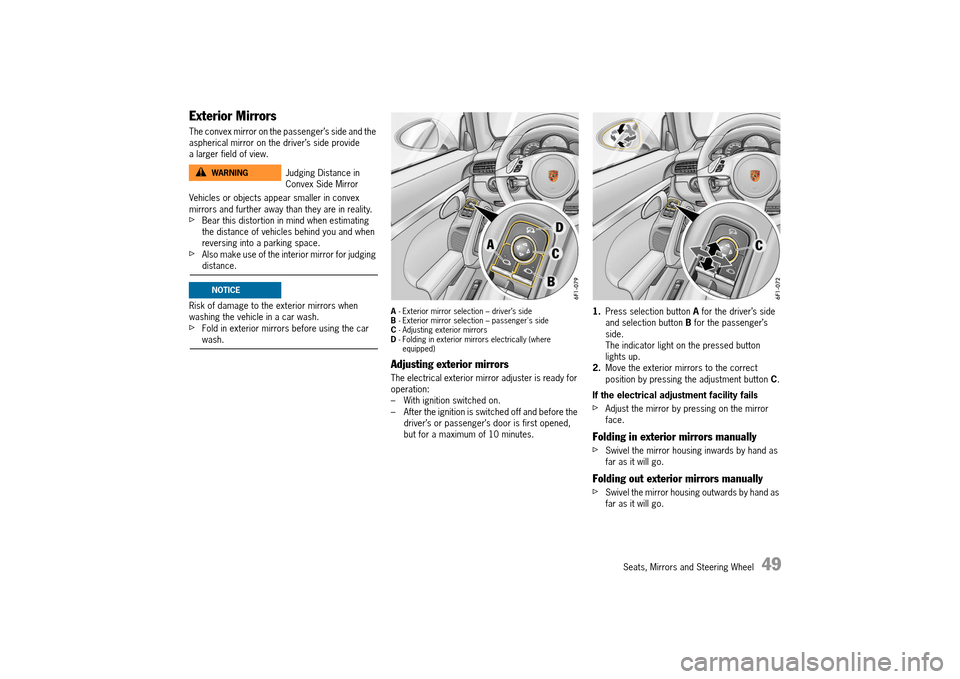
Seats, Mirrors and Steering Wheel 49
Exterior Mirrors
The convex mirror on the passenger’s side and the aspherical mirror on the driver’s side provide a larger field of view.
Vehicles or objects appear smaller in convex mirrors and further away than they are in reality.fBear this distortion in mind when estimating the distance of vehicles behind you and when reversing into a parking space.fAlso make use of the interior mirror for judging distance.
Risk of damage to the exterior mirrors when washing the vehicle in a car wash.fFold in exterior mirrors before using the car wash.
A - Exterior mirror selection – driver’s side B - Exterior mirror selection – passenger's side C - Adjusting exterior mirrors D - Folding in exterior mirrors electrically (where equipped)
Adjusting exterior mirrors
The electrical exterior mirror adjuster is ready for operation:– With ignition switched on.– After the ignition is switched off and before the driver’s or passenger’s door is first opened, but for a maximum of 10 minutes.
1. Press selection button A for the driver’s side and selection button B for the passenger’s side.The indicator light on the pressed button lights up.2. Move the exterior mirrors to the correct position by pressing the adjustment button C.
If the electrical adjustment facility fails
fAdjust the mirror by pressing on the mirror face.
Folding in exterior mirrors manually
fSwivel the mirror housing inwards by hand as far as it will go.
Folding out exterior mirrors manually
fSwivel the mirror housing outwards by hand as far as it will go.
Judging Distance in Convex Side Mirror
WARNINGh
NOTICE
14_991_Turbo_21.book Seite 49 Mittwoch, 9. April 2014 2:19 14
Page 53 of 300

Seats, Mirrors and Steering Wheel 51
Information
The anti-dazzle function switches off automatically if:– Reverse gear is engaged or– Interior lighting is switched on.
Switching on automatic anti-dazzle function
fPress button B. The indicator light A lights up.
Electrolyte fluid may escape from broken mirror glass. This fluid irritates the skin and eyes.fIf the electrolyte fluid should come into contact with the skin or eyes, rinse it off immediately with clean water.Seek medical attention if necessary.
Risk of damage to paintwork, leather, plastic parts and clothing.
Electrolyte fluid can be removed only while it is still wet.fClean the affected parts with water.
Automatic anti-dazzle exterior mirror
The exterior mirrors change to anti-dazzle position automatically in synchronization with the interior mirror.
Steering Wheel Heating
The steering wheel heating can be switched on and off using the button on the rear of the steering wheel when the ignition is switched on.
Switching steering wheel heating on/off
fPress button.The message “ Steering wheel heating switched on ” or “Steering wheel heating switched off ” appears on the multi-function display for 2 seconds.
Steering Wheel Adjustment
The steering wheel can be adjusted electrically in four directions depending on the vehicle equipment.
The steering wheel may move further than desired if you attempt to adjust it when driving.You may lose control of the vehicle.fDo not adjust the steering wheel when driving.
If persons or animals are in the movement range of the steering wheel during adjustment or if the person buttons are pressed unintentionally when the vehicle is at a standstill, parts of the body could get trapped or crushed.fDo not leave children in the vehicle unattended.
Electrolyte fluid may escape if the mirror glass is broken
CAUTIONh
NOTICE
Steering Wheel Adjustment While Driving
Memory Steering Wheel Movement
WARNINGh
CAUTIONh
14_991_Turbo_21.book Seite 51 Mittwoch, 9. April 2014 2:19 14
Page 60 of 300
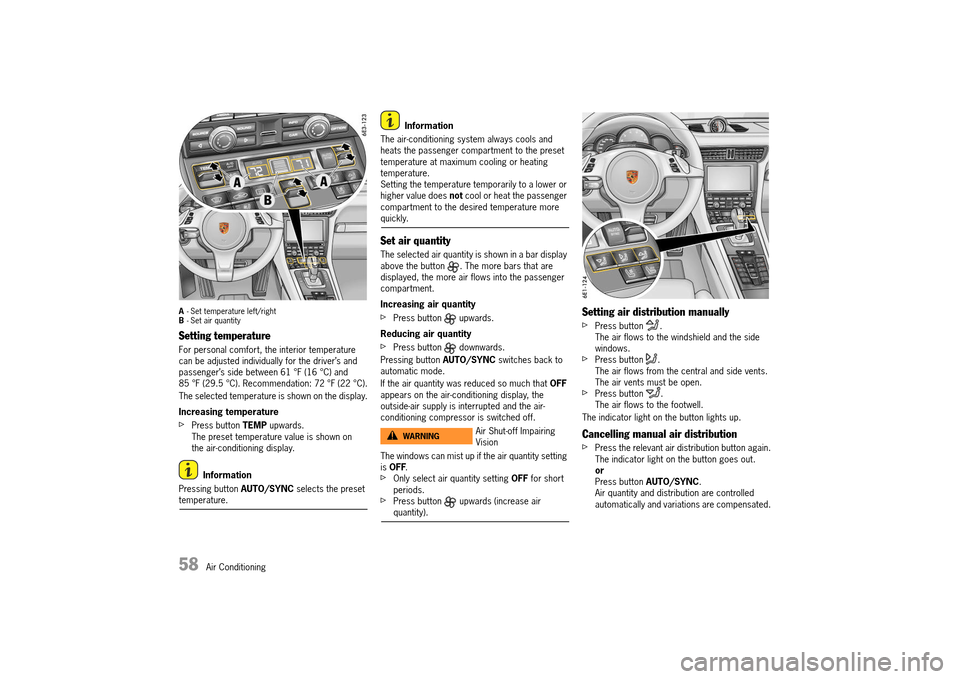
58 Air Conditioning
A- Set temperature left/right B - Set air quantity
Setting temperature
For personal comfort, the interior temperature can be adjusted individually for the driver’s and passenger’s side between 61 °F (16 °C) and 85 °F (29.5 °C). Recommendation: 72 °F (22 °C).
The selected temperature is shown on the display.
Increasing temperature
fPress button TEMP upwards. The preset temperature value is shown on the air-conditioning display.
Information
Pressing button AUTO/SYNC selects the preset temperature.
Information
The air-conditioning system always cools and heats the passenger compartment to the preset temperature at maximum cooling or heating temperature.Setting the temperature temporarily to a lower or higher value does not cool or heat the passenger compartment to the desired temperature more quickly.
Set air quantity
The selected air quantity is shown in a bar display above the button . The more bars that are displayed, the more air flows into the passenger compartment.
Increasing air quantity
fPress button upwards.
Reducing air quantity
fPress button downwards.
Pressing button AUTO/SYNC switches back to automatic mode.
If the air quantity was reduced so much that OFF appears on the air-conditioning display, the outside-air supply is interrupted and the air-conditioning compressor is switched off.
The windows can mist up if the air quantity setting is OFF.fOnly select air quantity setting OFF for short periods.fPress button upwards (increase air quantity).
Setting air distribution manually
fPress button . The air flows to the windshield and the side windows.fPress button .The air flows from the central and side vents. The air vents must be open.fPress button .The air flows to the footwell.
The indicator light on the button lights up.
Cancelling manual air distribution
fPress the relevant air distribution button again. The indicator light on the button goes out.orPress button AUTO/SYNC. Air quantity and distribution are controlled automatically and variations are compensated.
Air Shut-off Impairing VisionWARNINGh
14_991_Turbo_21.book Seite 58 Mittwoch, 9. April 2014 2:19 14
Page 79 of 300
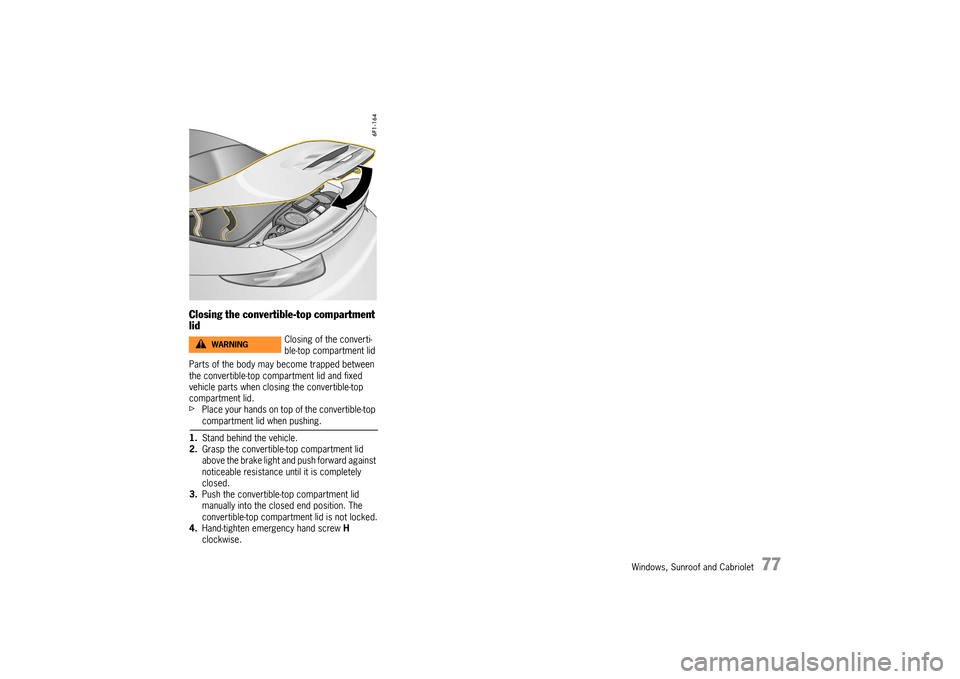
Windows, Sunroof and Cabriolet 77
Closing the convertible-top compartment lid
Parts of the body may become trapped between the convertible-top compartment lid and fixed vehicle parts when closing the convertible-top compartment lid.fPlace your hands on top of the convertible-top compartment lid when pushing.
1. Stand behind the vehicle. 2. Grasp the convertible-top compartment lid above the brake light and push forward against noticeable resistance until it is completely closed.3. Push the convertible-top compartment lid manually into the closed end position. The convertible-top compartment lid is not locked.4. Hand-tighten emergency hand screw H clockwise.
Closing of the converti- ble-top compartment lidWARNINGh
14_991_Turbo_21.book Seite 77 Mittwoch, 9. April 2014 2:19 14
Page 82 of 300

80 Lights, Turn Signals and Windshield Wipers
If you drive without lights, this may significantly restrict your visibility and also the ability of other road users to see your vehicle.fAlways carefully monitor the automatic driving light control.
Information
In the event of a fault in the automatic driving light assistant/Porsche Dynamic Light System (PDLS), the PDLS warning light in the instrument panel flashes.
For information on indicator lights and warning lights on the instrument panel:fPlease see the chapter “INSTRUMENT PANEL USA MODELS” on page 90.fPlease see the chapter “OVERVIEW OF WARNING AND INFORMATION MESSAGES” on page 129.
Rain function
The driving light is switched on automatically after five seconds of continuous wiper operation.
If the wipers have not been used for approx. 4 minutes, the driving light is switched off.
Automatic Coming Home lights (Welcome Home function/Entry function)
Switching on Automatic Coming Home lights
fSet light switch to .
The following lights remain switched on for a certain period to allow you to get in and out of your vehicle safely and with improved visibility in darkness:– Daytime driving lights,– Courtesy lights in the folded out exterior mirrors (on vehicles with electrically foldable mirrors),– Rear side marker lights,– License plate lights.
Welcome Home function (off delay)
When the vehicle is locked, the lights remain switched on for the duration of the off delay preset on the multi-function display.
For information on adjusting the off delay of the external lights on the multi-function display:fPlease see the chapter “ADJUSTING EXTERIOR LIGHTS” on page 120.
Entry function/Exit function
When the vehicle is unlocked, the area around the vehicle is illuminated for the duration of the off delay preset on the multi-function display.
The lights are switched off when the ignition is switched on or the light switch is set to a position other than .
For information on adjusting the off delay of the external lights on the multi-function display:fPLEASE SEE THE CHAPTER “ADJUSTING EXTERIOR LIGHTS” on page 120.
Porsche Dynamic Light System (PDLS)
Dynamic cornering light
Above a speed of approx. 5 mph (8 km/h), the low beam light is swiveled in the direction of the curve to illuminate the road more clearly, depending on the speed of the vehicle and the extent to which the steering wheel is turned.
In the event of a fault in the dynamic cornering light, the PDLS warning light in the instrument panel flashes.
Highway function in darkness
The distribution characteristics of the driving light change when driving in darkness at vehicle speeds above approx. 80 mph (130 km/h).The light beam becomes longer and the field of vision increases.
Fog lights
The distribution characteristics of the driving light change when the rear fog light is switched on at vehicle speeds below approx. 43 mph (70 km/h).The light beam becomes wider and reduces glare.
Driving without lightsWARNINGh
14_991_Turbo_21.book Seite 80 Mittwoch, 9. April 2014 2:19 14
Page 83 of 300

Lights, Turn Signals and Windshield Wipers 81
Porsche Dynamic Light System Plus (PDLS Plus)
High Beam Assistant
When High Beam Assistant is switched on, a camera A detects the light sources of oncoming vehicles and vehicles in front, and automatically selects between low beam and high beam.The function activates in darkness if the following conditions are present:– Light switch position is selected.– Vehicle speed is more than approx. 37 mph (60 km/h).– High Beam Assistant is activated on the multi-function display in the instrument panel.Please see the chapter “ACTIVATING AND DEACTIVATING HIGH BEAM ASSISTANT” on page 120.
– High Beam Assistant on is selected on the high beam stalk.Please see the chapter “ACTIVATING/DEACTIVATING HIGH BEAM ASSISTANT” on page 82.
As an anti-glare precaution for built up areas, High Beam Assistant is not available at speeds below 20 mph (30 km/h).
The lights also switch from high to low beam automatically as soon as a built up area is detected.
For information on warning messages on the multi-function display:fPlease see the chapter “OVERVIEW OF WARNING AND INFORMATION MESSAGES” on page 129.
Information
fTo help make sure that nothing interferes with camera operation:Do not block the camera area A with objects (e.g. stickers).fThe camera A must always be kept free of dirt, ice and snow to ensure that it is fully functional.For car care instructions: Please see the chapter “CAR CARE INSTRUCTIONS” on page 231.
The driver remains responsible while driving, e.g. manually operating the high beam according to light, visibility and traffic conditions, regardless of High Beam Assistant. The system is no substitute for careful attention on the part of the driver.Manual intervention may be required in the following situations:– In unfavorable weather conditions, e.g. rain, snow, ice, heavy spray.– On roads where oncoming traffic is partly obscured, e.g. highways.– Where there are road users with poor lights, e.g. cyclists.– On tight bends, or on sharp humps or dips.– In poorly lit built up areas.– Where there are strong reflections, e.g. signs.– Where the windshield in the camera area is misted, dirty, icy or covered with stickers.fDrive with extreme care.fAlways pay attention to the traffic situation and the area around the vehicle.fChange to using the high beam manually according to light, visibility and traffic conditions.
Lack of attentionWARNINGh
14_991_Turbo_21.book Seite 81 Mittwoch, 9. April 2014 2:19 14